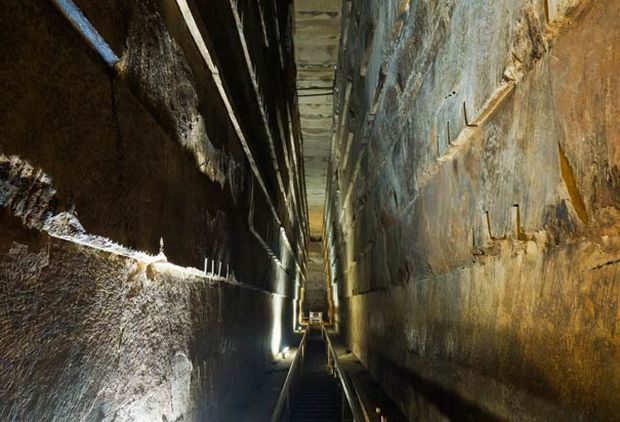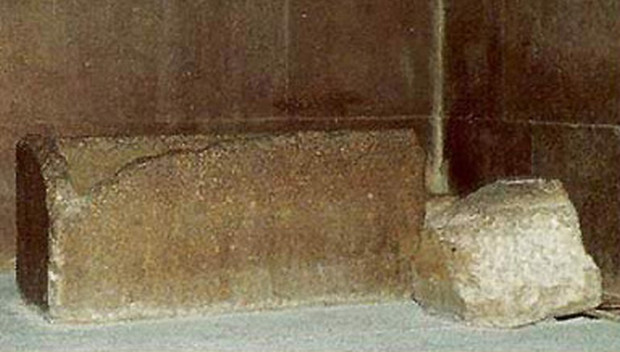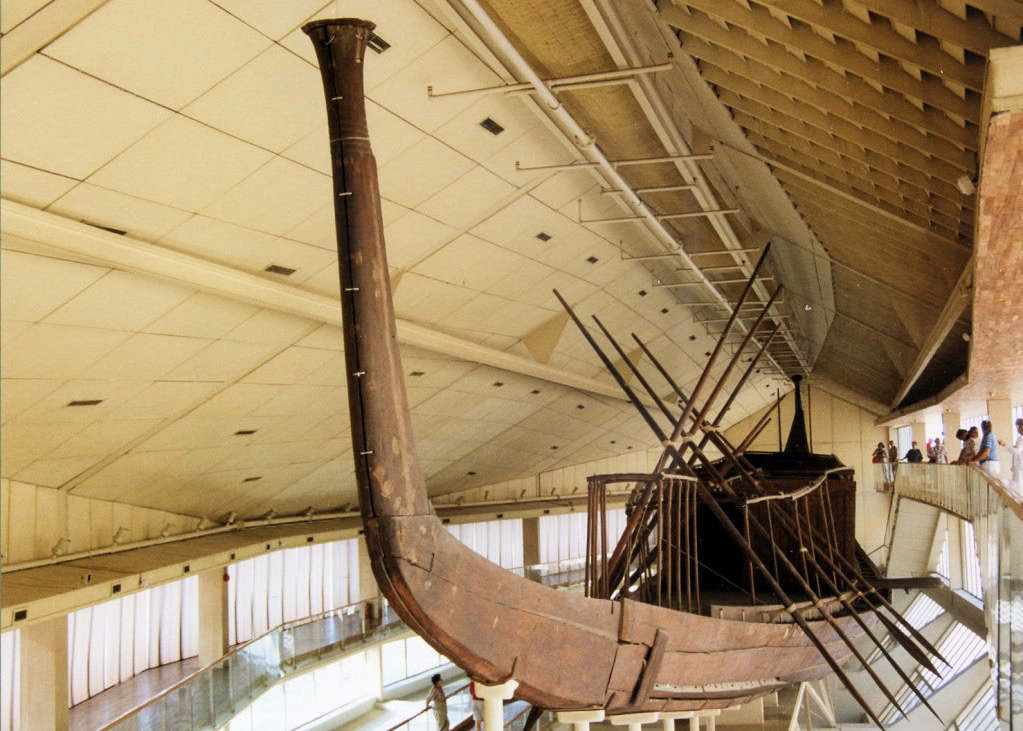The Great Pyramid of Khufu stands as a proud testimony to the extraordinary vision and engineering skills of the ancient Egyptians. It has survived virtually intact over the centuries and is the only one of the Seven Wonders of the Ancient World in existence today. Rising starkly from the flat desert plain 7½ miles (12km) outside Cairo, the three great pyramids of Giza tower over a surrounding complex of subsidiary pyramids and tombs. Nearby lies the statue of the Great Sphinx. These wonders of the ancient world have survived nearly 5000 years, but it is only since the 19th century that archaeologists have begun to piece together how and why they were built.
The town of Giza is situated near where the River Nile divides to fan across the delta, the point which once marked the boundary, between Upper and Lower Egypt. When these two kingdoms were united in about 2925 BC, the new state of Egypt established its capital nearby at Memphis, on the west bank of the Nile. This became the home of the pharaohs, who then ruled for the following 3000 years through 30 consecutive dynasties.
The three great pyramids of Giza were erected during the fourth dynasty (about 2575-2465 BC). The largest, the tomb of the pharaoh Khufu, called Cheops by the Greek historian Herodotus, was the first to be built. The central pyramid, the second to be built, is slightly smaller and belongs to the pharaoh Khafre, or Chephren, Khufu’s son. The third, and much smaller, pyramid is that of the pharaoh Menkaure, or Mycerinus, Khufu’s grandson.
The pharaohs were regarded as living gods, destined at death to join the many other gods worshipped by the Egyptians. Some gods, such as Osiris, ruler of the dead, and the jackal-headed Anubis, officiated at the judgment of the dead. Egyptian rulers built themselves ‘houses of death’ containing a complete suite of underground rooms furnished with all the things they would need in the afterlife, including food, utensils and jewelry. These tombs are strategically situated at the edge of the desert on the west bank of the Nile. (Since the west is where the sun sets, the ancient Egyptians associated it with death.)
The Egyptians believed that in order to enjoy the afterlife their bodies had to be preserved intact and so they developed the art of mummification. The word mummy comes from the Arabic mumiya, ‘bitumen’, since preserved corpses blackened by age were once thought to have been soaked in tar.
The embalming process began by making an incision in the abdomen through which the intestines, lungs, liver and stomach were removed. The brain was extracted through a cut in the base of the skull. These were preserved separately and stored in jars alongside the body (in later times, they were returned to the body). To remove all the body fluids, the corpse was packed with natron, a natural salt from a dried lake in the Nile delta containing a high proportion of sodium bicarbonate. It is thought that this was the reason why after six to eight weeks the body was dry and stable. Finally, the body was wrapped in several layers of linen bandages. Sometimes, after bandaging the face of the mummy was covered with a mask. The mummy was then placed in a contoured wooden coffin. This was plastered, then painted with an idealized figure of the deceased.
Jackal-headed Anubis was an ancient Egyptian god of the dead, particularly associated with the funeral cult. He was considered to be the inventor of embalming, an act he first performed on the god Osiris, who, aptly for the ruler of the dead, is often represented as a mummy.

The early pharaohs of the first and second dynasties built small rectangular tombs, or mastabas, such as those found at Saqqara, west of Memphis, and Abydos. But a hundred years before work began on the pyramids at Giza, Zoser, a pharaoh of the third dynasty, revolutionized tomb architecture by building the first pyramid. It rose in six magnificent steps to tower 200ft (60m) over the desert at Saqqara and, unlike any other building before it, was dressed in stone.
Later pharaohs developed a smooth-sided shape, as seen in the Red Pyramid at Dashur, and this design culminated in the magnificent pyramid of Khufu (the top is now missing) originally rose to a height of 481ft (146.6m). It is so large that, according to one estimate, Westminster Abbey and St. Paul’s Cathedral in London, St Peter’s in Rome and the cathedrals of Florence and Milan could all fit inside. Some 2½ million stone blocks, each weighing on average 2½ tons, were used in its construction. These blocks were put together without mortar and fitted so closely that the British Egyptologist Flinders Petrie (1853-1942) observed that ‘neither needle, nor hair’ could be inserted into the joints.
This massive construction, which took approximately 30 years to complete, was not only an astonishing feat of engineering but also required the transportation of tons of materials and the effective organization of an estimated 100,000 men. Most of the stone was hewn from local quarries, but the limestone facing had to be brought from Tura on the east bank of the Nile 8 miles (13km) away, while the pink granite that lined the burial chamber came from Aswan, more than 600 miles (965km) to the south.
Some scientists maintain that the ancient Egyptians used a spiral ramp, wrapping it around the pyramid in stages as it was built. An extended ramp, they argue, would have required a prohibitive amount of material and would itself have been a major construction.
Another method proposed by scientists is called the extended ramp method in which the stone blocks used for building a pyramid were brought to the site on sledges. Once the bottom layer of stone was in place, an earth ramp was constructed on one side of the pyramid. Men dragged the blocks up this ramp, which was made higher as the work progressed until it reached the apex. Dressed stone was then used to face the pyramid, starting at the top with a capping stone. The ramp was then gradually dismantled as the pyramid casing drew nearer the ground.
The first entry into Khufu’s tomb since ancient times was made in the ninth century on the orders of Ma’amun, the caliph of Baghdad, who was hoping to find treasure. His men broke in through the north wall and eventually reached the King’s Chamber, only to find it empty of treasure and other goods. Archaeologists are still puzzled as to why it should have been empty when there was no evidence that the tomb had previously been plundered.
The majestic proportions of the Grand Gallery, which leads from the ascending passage to the King’s Chamber in the Great Pyramid, have long puzzled historians. The gallery may have been used to house the huge granite blocks which were slid down the corridor to seal it after the funeral.

Today, tourists use the same north entrance. Inside, one passage goes down to an unfinished burial chamber and another, the ascending passage, leads up to the King’s Chamber in the heart of the monument. Off the same passage is a corridor leading to another unfinished room known as the Queen’s Chamber; beyond that is a narrow passage, discovered in April 1993, leading to a small door.

Near the Great Pyramid stand the tombs of Khufu’s officials and relatives. There are also rows of mastabas and small boat pits, long since emptied of their contents by grave robbers. In 1954, the dismantled sections of a large boat were discovered in the sand on the southern side of the pyramid and reassembled – a task that took ten years. It may have been a state boat during Khufu’s lifetime or intended for use after his death.
The dismantled boat excavated near Khufu’s pyramid is 142ft (43.3m) long and 19½ft (5.9m) wide at the centre. The boat pit contained 1224 pieces of wood, probably cedar from the Lebanon, arranged in 13 layers. Ropes and oars were also found. The boat’s function is unclear. Perhaps it was used to carry the pharaoh’s body to Giza for embalming and burial, or it may have been a ‘sun boat’ to ferry his soul across the heavens. It is on display in a museum next to the pyramid.

The perfect orientation of the Great Pyramid, whose square base was aligned almost exactly north-south and east-west, and various mystical interpretations of pyramidal measurements, have led to some strange theories about the purpose of the pyramids. Several 19th century British astronomers claimed that the pyramids were intended as astronomical observatories and could have been used as sundials.
One astronomer, Charles Piazzi Smyth, used pyramidal measurements to ‘prove’ that the pyramids were the work of God the ‘Divine Geometer’ and that they contained information revealing the date of the Second Coming of Christ. Other pyramidologists believe that the pyramids were built by aliens from outer space.
Archaeological and literary evidence suggests that the pyramids were funeral monuments, but not necessarily the burial places of pharaohs. One of their functions may have been to house the ka, or soul, which the ancient Egyptians believed would survive after death. The sheer grandeur of the pyramids was criticized in Roman times. Pliny the Elder (AD 23-79) called them ‘vain and foolish ostentatious of the fortunes of kings’. But Pliny could not foresee that in its ostentation the Great Pyramid of Khufu was to achieve its maker’s dream of immortality by keeping his name alive for almost 5000 years.
-end-




































